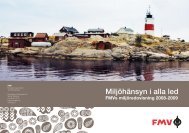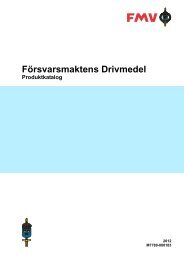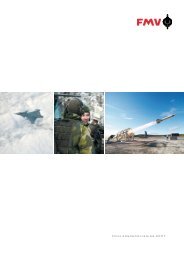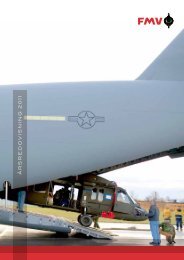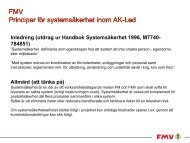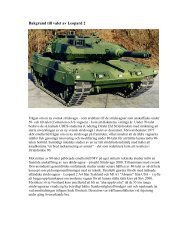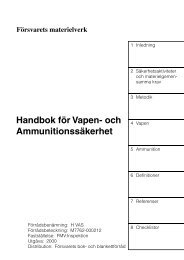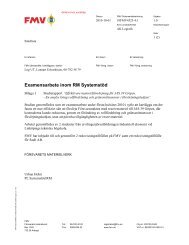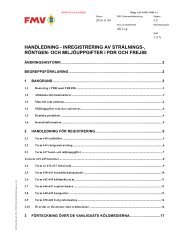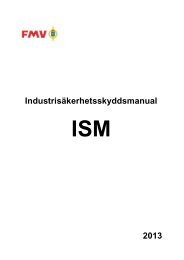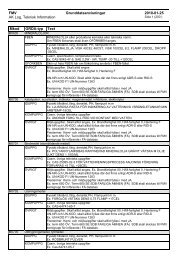Återvinningsmanual sv eng version 2Pdf, 51 kB - FMV
Återvinningsmanual sv eng version 2Pdf, 51 kB - FMV
Återvinningsmanual sv eng version 2Pdf, 51 kB - FMV
Create successful ePaper yourself
Turn your PDF publications into a flip-book with our unique Google optimized e-Paper software.
<strong>FMV</strong>/Mall BILAGA TILL UPPRÄTTAD HANDLING/Utgåva nr 12.0<br />
<strong>Återvinningsmanual</strong><br />
Inledning<br />
Syftet med återvinningsmanualen är att ge<br />
det underlag som krävs för att systemet vid<br />
avveckling skall kunna omhändertas på ett<br />
sätt som minimerar påverkan på hälsa och<br />
miljö. <strong>Återvinningsmanual</strong>en skall vara ett<br />
underlag för de riskbedömningar som<br />
genomförs vid en avveckling.<br />
Vid avveckling används generellt följande<br />
prioriteringsmodell:<br />
1. fortsatt användning, exempelvis<br />
uppgradering, reparation, användning<br />
i annan funktion.<br />
2. återanvändning, exempelvis som<br />
reservdelar eller i nytillverkade<br />
produkter.<br />
3. återvinning av material, exempelvis<br />
metaller och plaster<br />
4. återvinning av energi, exempelvis<br />
genom förbränning<br />
5. deponering.<br />
<strong>Återvinningsmanual</strong>en skall ge information<br />
om miljö- och hälsofarliga ämnen,<br />
komponenter och material som kan<br />
förekomma i systemet. Vidare skall<br />
återvinningsmanualen också innehålla den<br />
information som behövs för att graden av<br />
återanvändning eller återvinning av systemet<br />
och dess komponenter blir så hög som<br />
möjligt, bland annat genom att underlätta val<br />
av återanvändnings- eller återvinningsmetod<br />
vid en framtida skrotning av hela eller delar<br />
av systemet. <strong>Återvinningsmanual</strong>en skall inte<br />
beröra avveckling genom försäljning.<br />
<strong>Återvinningsmanual</strong>en skall minst bestå av<br />
nedanstående information:<br />
1. Sammanfattning<br />
Avsnittet skall innehålla en kortfattad<br />
beskrivning av systemet och en<br />
sammanfattning av den viktigaste<br />
informationen i dokumentet.<br />
ÖPPEN/UNCLASSIFIED Bilaga nr 1 till 24 100:32822/2008<br />
Date <strong>FMV</strong> Document reference Versiom<br />
18 June<br />
2008<br />
32822/2008 2.0<br />
Area of responsibility/Unit Classification no.<br />
Gen prodstöd 24 100<br />
Recycling Manual<br />
Introduction<br />
Page<br />
1 (4)<br />
The aim of this recycling manual is to provide<br />
all the information that is required to dispose<br />
of the system in a way that minimises the<br />
effect on people’s health and the surrounding<br />
environment. This manual forms the basis of<br />
risk analyses that have to be carried out<br />
before phasing the system out.<br />
The following priority model is normally used<br />
for the phase-out:<br />
1. continued use, e.g. upgrading, repair,<br />
use in another function<br />
2. reuse, e.g. as spare parts or in newly<br />
manufactured products<br />
3. recycling the materials, e.g. metals<br />
and plastics<br />
4. energy recovery, e.g. through<br />
incineration<br />
5. controlled disposal.<br />
The recycling manual should provide<br />
information on substances, components and<br />
materials in the system that present a risk to<br />
health and the environment. It should also<br />
include information that will help to maximise<br />
the reuse and recycling of the system and its<br />
components. For example, this information<br />
should be helpful when deciding which reuse<br />
or recycling methods should be used when<br />
scrapping either all or parts of the system. It<br />
should not look at phasing out the system by<br />
selling it.<br />
The manual should contain at least the<br />
following information:<br />
1. Summary<br />
This section gives a short description of the<br />
system and a summary of the most important<br />
information in the document.
<strong>FMV</strong>/Mall BILAGA TILL UPPRÄTTAD HANDLING/Utgåva nr 12.0<br />
2. Gällande regler och<br />
lagstiftning<br />
Avsnittet skall ge en beskrivning om systemet<br />
och/eller komponenter eller material i<br />
systemet berörs av några särskilda regler<br />
eller lagstiftning som påverkar återvinningen<br />
av systemet. Gällande lagstiftning vid<br />
fastställande av återvinningsmanualen skall<br />
redovisas. Kända förändringar i framtida<br />
lagstiftning som kan beröra återvinnings-<br />
manualen bör redovisas.<br />
3. Märkning av material<br />
Avsnittet skall innehålla en beskrivning över<br />
hur eventuell märkning av material och<br />
komponenter ser ut i systemet och om<br />
märkningen bygger på någon standard.<br />
4. Återvinningsbarhet<br />
Avsnittet skall innehålla en beskrivning över<br />
hur stor del av systemet som kan återvinnas i<br />
viktprocent. Avsnittet bör innehålla en<br />
beskrivning som anger de andelar i<br />
viktprocent av systemet som kan återvinnas.<br />
5. Materialinnehåll<br />
Avsnittet skall innehålla en beskrivning över<br />
de olika materialslag som förekommer i ett<br />
komplett system. Om en särskild<br />
materialdeklaration upprättats bör denna<br />
bifogas återvinningsmanualen eller hänvisas<br />
till.<br />
Följande material skall vid förekomst<br />
redovisas, med vikt och placering:<br />
• metaller (indelat i de största<br />
fraktionerna)<br />
• plaster (indelat i de största<br />
fraktionerna)<br />
• elektronik (innehåll på övergripande<br />
nivå, exempelvis kretskort, kylfläkt)<br />
ÖPPEN/UNCLASSIFIED Bilaga nr 1 till 24 100:32822/2008<br />
Date <strong>FMV</strong> Document reference Versiom<br />
18 June<br />
2008<br />
32822/2008 2.0<br />
Area of responsibility/Unit Classification no.<br />
Gen prodstöd 24 100<br />
Page<br />
2 (4)<br />
2. Current regulations and<br />
legislation<br />
This section describes any special<br />
regulations or legislation that could affect the<br />
recycling of the system and its components. It<br />
should describe the legislation that applies at<br />
the time the recycling manual is produced. It<br />
must also describe any known changes that<br />
will be made in future legislation that could<br />
affect the recycling manual.<br />
3. Marking of materials<br />
This section describes any marking of<br />
materials and components in the system and<br />
whether this marking is based on any specific<br />
standards.<br />
4. Recyclability<br />
The section describes how much of the<br />
system can be recycled, with figures quoted<br />
as a weight percentage. It should include a<br />
description of the parts of the system that can<br />
be recycled, expressed as a weight<br />
percentage.<br />
5. Contents of materials<br />
This section describes the different kinds of<br />
materials that can be found in a complete<br />
system. If a materials declaration has been<br />
drawn up, this must be enclosed with the<br />
recycling manual or should include<br />
references to this.<br />
Describe where the following materials are<br />
located in the system and their weight:<br />
• metals (divided into the largest<br />
fractions)<br />
• plastics (divided into the largest<br />
fractions)<br />
• electronics (general contents, e.g.<br />
printed circuit card, cooling fan)
<strong>FMV</strong>/Mall BILAGA TILL UPPRÄTTAD HANDLING/Utgåva nr 12.0<br />
• kompositer<br />
• kemiska produkter (exempelvis oljor)<br />
• gummi<br />
• strålkällor<br />
• övriga material som är relevanta att<br />
redovisa (till exempel trä, glas,<br />
keramiska material).<br />
6. Enheter<br />
Avsnittet skall ge en beskrivning över de<br />
största enheterna i systemet inklusive<br />
huvudsakligt materialinnehåll och vikt.<br />
Exempel på sådana enheter är motor,<br />
transmission och axlar.<br />
Beskrivningen skall minst innehålla följande<br />
information: enhetens namn, placering i<br />
systemet (illustrerat med figur),<br />
materialinnehåll samt annan information som<br />
bedöms vara relevant för säkert<br />
omhändertagande. Finns annan relevant, ur<br />
miljö- och säkerhetssynpunkt, information i<br />
annan dokumentation, hänvisa till denna.<br />
7. Uppgifter för sanering och<br />
demontering av systemet<br />
Avsnittet skall innehålla följande information:<br />
7.1 Tömning av kemiska produkter<br />
Beskriv mängd, typ och var i systemet<br />
kemiska produkter (oljor, hydraulvätskor,<br />
köldmedia etc) förekommer. Beskriv kort vilka<br />
miljö- och hälsorisker som är förenad med<br />
den kemiska produkten, även risker kopplade<br />
till tryck, temperatur o<strong>sv</strong> skall redovisas.<br />
Hänvisa till instruktioner, t ex reparations-<br />
manualer, som beskriver hur tömning skall<br />
utföras. Finns inte sådan information i annan<br />
dokumentation skall denna information ges i<br />
återvinnings- manualen. Illustrera med figur<br />
var i systemet varje kemisk produkt<br />
förekommer. Säkerhetsdatablad för dessa<br />
produkter skall bifogas återvinnings-<br />
manualen.<br />
ÖPPEN/UNCLASSIFIED Bilaga nr 1 till 24 100:32822/2008<br />
Date <strong>FMV</strong> Document reference Versiom<br />
18 June<br />
2008<br />
32822/2008 2.0<br />
Area of responsibility/Unit Classification no.<br />
Gen prodstöd 24 100<br />
Page<br />
3 (4)<br />
• composites<br />
• chemicals (e.g. oils)<br />
• rubber<br />
• radioactive sources<br />
• other materials that are relevant from<br />
an environmental and safety point of<br />
view (e.g. wood, glass, ceramic<br />
materials).<br />
6. Components<br />
Describe the main components of the system,<br />
including their material content and their<br />
weight. These components include, for<br />
example, the <strong>eng</strong>ine, transmission and axles.<br />
This description should include at least the<br />
following: the name of the component, its<br />
location in the system (illustrated using a<br />
diagram), materials and other information that<br />
is relevant to ensure that everything can be<br />
handled in a safe manner. Reference should<br />
be made to any documentation that includes<br />
relevant information about safety and the<br />
environment.<br />
7. Information for decontamina-<br />
tion and dismantling the system<br />
This section includes the following<br />
information:<br />
7.1 Emptying any chemical<br />
products<br />
Describe the quantity of chemical products<br />
(oils, hydraulic liquids, refrigerants etc.) in the<br />
system including their type and location. Give<br />
a brief description of the environmental and<br />
health risks associated with the chemical<br />
product; it is important to include risks linked<br />
to temperature and pressure. Refer to<br />
instructions, e.g. repair manuals, which<br />
describe how chemicals should be emptied. If<br />
this information cannot be found in any other<br />
documentation, it must be included in this<br />
recycling manual. Use a diagram to illustrate<br />
where every chemical product can be found<br />
in the system. Safety data sheets for these<br />
products must be enclosed with the manual.
<strong>FMV</strong>/Mall BILAGA TILL UPPRÄTTAD HANDLING/Utgåva nr 12.0<br />
7.2 Demontering av eventuella<br />
joniserande strålkällor<br />
Beskriv mängd, typ och var i systemet<br />
strålkällor förekommer. Beskriv kort vilken<br />
risk som är förenad med strålkällan. Hänvisa<br />
till instruktioner och andra dokument som<br />
beskriver hur demontering, förvaring och<br />
omhändertagande skall utföras. Finns inte<br />
sådan information i annan dokumentation<br />
skall detta beskrivas i återvinningsmanualen.<br />
Illustrera med figur var i systemet varje<br />
strålkälla förekommer.<br />
7.3 Information om konstruktions-<br />
material<br />
Konstruktionsmaterial med miljö- och<br />
hälsofarliga egenskaper bör avlägsnas innan<br />
en demontering. Beskriv kort vilka risker som<br />
är förenad med konstruktionsmaterialet.<br />
Exempel är material innehållande bly,<br />
kvicksilver, berylliumoxid, asbest, etc.<br />
Hänvisa till instruktioner, t ex reparations-<br />
manualer som beskriver hur säker<br />
borttagning skall utföras. Finns inte sådan<br />
information i annan dokumentation skall<br />
denna information ges i återvinnings-<br />
manualen. Illustrera med figur var i systemet<br />
dessa material förekommer.<br />
7.4 Övriga komponenter med miljö-<br />
och säkerhetsrisker<br />
Beskriv var andra komponenter med miljö-<br />
och säkerhetsrisker finns i systemet. Exempel<br />
på sådana komponenter är filter, batterier,<br />
tryckkärl, spända fjädrar, släcksystem,<br />
klimatanläggning etc. Beskrivningen skall<br />
innehålla en kort beskrivning över vilken risk<br />
som är förenad med komponenten. Hänvisa<br />
till instruktioner t ex reparationsmanualer som<br />
beskriver hur säker borttagning skall utföras.<br />
Finns inte sådan information i annan<br />
dokumentation skall denna information ges.<br />
ÖPPEN/UNCLASSIFIED Bilaga nr 1 till 24 100:32822/2008<br />
Date <strong>FMV</strong> Document reference Versiom<br />
18 June<br />
2008<br />
32822/2008 2.0<br />
Area of responsibility/Unit Classification no.<br />
Gen prodstöd 24 100<br />
Page<br />
4 (4)<br />
7.2 Dismantling any ionizing<br />
radiation sources<br />
Describe the quantity and type of radiation<br />
sources as well as their location in the<br />
system. Give a brief description of the risks<br />
associated with the radiation source. Refer to<br />
instructions and other documents, which<br />
describe how to dismantle, store and take<br />
care of the products. If this information cannot<br />
be found in any other documentation, it must<br />
be included in this recycling manual. Use a<br />
diagram to illustrate where every radiation<br />
source can be found in the system.<br />
7.3 Information about construction<br />
materials<br />
Construction materials that constitute a risk to<br />
health and the environment should be<br />
removed before dismantling. Give a brief<br />
description of the risks associated with the<br />
construction material. These materials<br />
include lead, mercury, beryllium-oxide,<br />
asbestos etc. Refer to instructions e.g. repair<br />
manuals, which describe how to remove the<br />
component safely. If this information cannot<br />
be found in any other documentation, it must<br />
be included in this recycling manual. Use a<br />
diagram to illustrate where these materials<br />
can be found in the system.<br />
7.4 Other components associated<br />
with environmental and safety risks<br />
Describe the location of other components<br />
that present a risk to the environment and to<br />
safety. These components include, for<br />
example, filters, batteries, pressure valves,<br />
coiled springs, extinguishing systems, climate<br />
installations etc. Give a brief description of<br />
the kinds of risks that are associated with a<br />
particular component. Refer to instructions<br />
e.g. repair manuals, which describe how to<br />
remove the component safely. If this<br />
information cannot be found in any other<br />
documentation, it must be included in this<br />
recycling manual.




